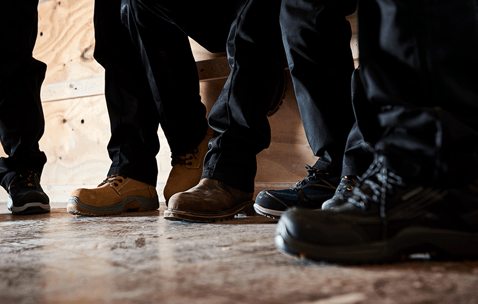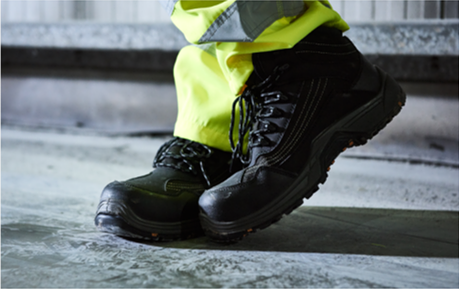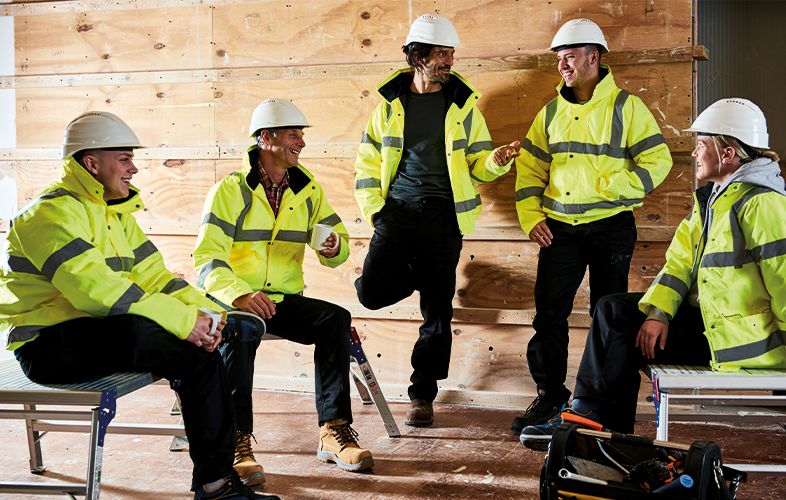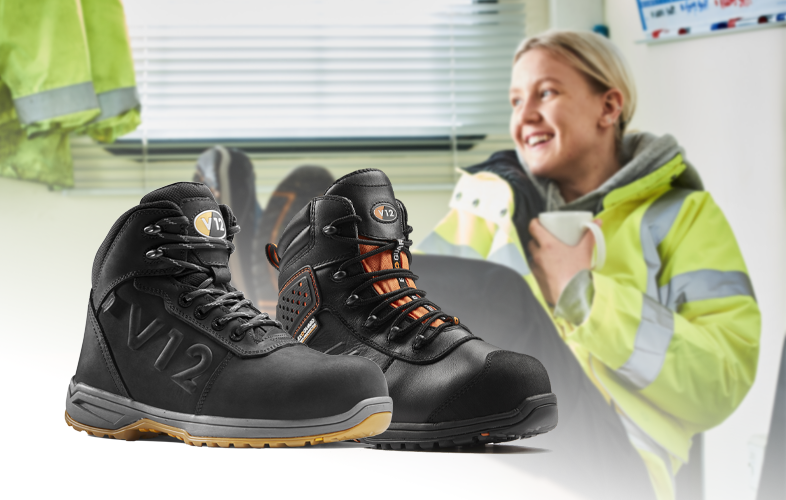It’s easy to assume that the more safety features a work boot has, the better – and safer - it is. In this blog, we’ll illustrate how this isn’t necessarily the case and that in fact, when it comes to the specification of your work boot, less is sometimes more. We’ll also highlight that contrary to what many work boot wearers might think, safety doesn't have to cost the earth.
THE RIGHT SPECIFICATION
When a boot has the correct specification or ‘spec,’ it has the right safety features to appropriately protect the wearer from the hazards they encounter at work. As you can imagine, when a boot doesn’t offer sufficient protection - or is under-specced (more on this later) – this creates a big safety issue. But in terms of both safety and cost, an over-specced boot can be just as problematic.
WHAT IS ‘OVER-SPECCING?’
Over-speccing (or over-specification) is when a work boot has unnecessary or surplus features that won't give the wearer any added value or protection.
THE ISSUES WITH OVER-SPECCING
Financial
The first and most obvious downside to an over-specced boots is cost – or rather, the unnecessary and avoidable cost. In most respects, the more components built into a safety boot, the more expensive it gets, because of the added materials and labour. So, wearing a work boot with a series of specialised safety features which are supposed to mitigate hazards that the wearer will never encounter is a bit of a waste of money. You wouldn’t buy a suit of armour to fry an egg, would you?
Hurting not helping
But an over-specced boot could even hinder you at work. For example, if you work in a slip-free environment, wearing a boot with a chunky and wide sole designed to grip loose, natural terrain could mean you end up carrying unnecessary extra weight without any real benefit.
Similarly, someone who worked outdoors might think they needed a boot with a fully waterproof membrane, whereas if they only encounter infrequent or light rain, they might only require a boot with a leather upper to handle the water-resisting duties.
Hidden benefits
When wearers or procurers realise they don’t need these extra components in safety footwear, they also begin to reduce plastic use as well as save money. Finally, not having features such as waterproofing components could also give the wearer foot health benefits, as feet stay a lot more breathable when not encased in linings and membranes.
Take-home tip:
The right boot isn’t the boot with the most protection – it’s the boot with the right protection for the specific application.
SPEC AND YOUR ENVIRONMENT
Getting the right spec is also key in terms of maintaining the durability of your boot. Safety features like toecaps, metatarsal guards, scuff caps and other components aren't just inserted casually into generic boots - they're designed, developed, and manufactured with specific processes, for specific applications. So, if you're using your safety footwear and its spec for the wrong purpose, you'll either end up with a boot that won't last long or will end up causing you extra weight – think tired legs after carrying extra weight all day – and extra cost.
Take-home tip:
When it comes to specification – be it under or over – you'll want to avoid both.
SO HOW DO I GET THE RIGHT BOOT FOR ME?
SOLUTIONS BEHIND THE BOOTS

The margins between pain and comfort are often fine. Seemingly small footwear solutions such as insoles can make an enormous difference to foot health, particularly if – as V12’s are – insoles are designed based on the last shape of the boots they're in, so they pair perfectly with the footwear to provide optimum support. For V12, our insoles are just as reflective of our contoured last shape as the boot itself.
Many wearers think that it is the boots which provide the safety, and to get the comfort, they must look for specialised insoles - sometimes spending up to £30 or even £40 on them. But a boot that comes with an insole that's been made with comfort at the fore and developed based on a specific last shape means comfort is already at your feet.
Take-home tip:
Unless you’ve been prescribed a specialised custom orthotic by a doctor, there is no need to spend the earth to stay comfortable and safe.
For more information on how comfort insoles can be low cost but high-impact, take a look at the video below.
Interested in finding out more about insoles as a foot health and comfort solution? Read our blog here.
KNOW THE DIFFERENCE BETWEEN PRICE AND VALUE
Price is often a complex issue for buyers, and while sometimes rather than stumping up a lot of cash, people will understandably want to do the opposite and try to spend less. However, spending significantly less could backfire...
Imagine 2 pairs of safety boots - one is £30 and the other £75. Now, it would be tempting to buy the boots with a smaller price tag – but these boots will be £30 pounds for a reason. The spec, quality of components and the comfort will be a lower standard than the £75 pair. So if someone wears the £30 pair every day, putting them through their paces against hazards and the elements, they’ll probably need replacing 3 times a year.
Now multiply 30 by 3.
Their actual cost per year then is £90. So, the £75 pair which will still be going strong after 12 months due to their higher quality are now the cheaper boot over the year. They cost more but have greater value.
Take-home tip:
For a compliant and well performing safety boot, spending a little more in the short term can often save you money.
Do you want to find out more about cost in use and safety footwear? Head to this blog and find out all there is to know.
PAYING FOR A NAME?
There is also a danger that consumers end up paying a higher price because they associate well-known international brands with high-quality, whereas in fact, there might be more budget-supporting options elsewhere on the market. We are often given the impression that a product is superior thanks to effective marketing, which convinces us we can’t make do with another, perhaps lesser-known brand. In fact, some products promoted by large-scale marketing campaigns can sometimes become more expensive because of the cost of these promotions.
Furthermore, people often make their buying decisions based on word of mouth, and due to a larger reach, this can lead them to well-established or more ‘prestigious’ brands, as they are the most well-known. Also, when a brand has popularity, they often have the leverage to raise their prices as they have assured loyalty from a lot of customers.

And of course, there are those who rather than being put off by a high price will find it reassuring, seeing it as a sign of quality and reliability. And this is absolutely sound logic, but at the same time, it’s important to remember that by researching alternative brands, it's often possible to find products with the right specification at a much more manageable cost.
It is worth noting that we are not stating that an international well-known brand wouldn’t offer you high-quality goods at a justified price - but we are outlining that you should keep it as a consideration when researching your next pair of safety boots.
Take-home tip:
Safety is crucial, but if you’re shelling out for a name, it might be time to shop around.
APART FROM THE COMPONENTS, WHAT ELSE AFFECTS THE PRICE OF A SAFETY BOOT?
Many understandably assume that the price of a safety boot is determined solely by the quality of the material and amount of components - and while this is true, there are often other factors at play that affect the cost to the customer.
Geography
The eventual price of a safety boot can be determined by which country it’s made in. A lot of companies manufacture their products in the Far East for example because they’re closer to the required raw materials. For example, so much of the world’s footwear is manufactured in Asia because 40% of all the cows in the world can be found in China and India. As a result, leather is on the doorstep for many of these factories, which drives down the cost.
Labour
Safety boot manufacturing is a complex process, largely since unlike a lot of sectors, the footwear industry still features very labour-intensive processes and doesn’t include a lot of automation happening in factories in other areas of manufacturing.
In some areas of Far Eastern nations – while slowly improving for many workers, wages are still relatively low, which helps to keep overheads down for companies. However, some brands are transitioning away from factories in the Far East for reasons such as the environmental cost of shipping. Many companies also believe having their products manufactured in western factories is more ethical and sustainable, but if you buy a product that has been made in factories in the UK or USA, the price would be greater, as the labour wage rate is much higher in these countries. And some would argue, rightly so.
YOU CAN SPREAD THE COST WHEN BUYING

Look out for this option on sites when looking to buy your boots. There are a number of different payment methods including Clearpay - which is the one available on our own website – enabling you to spread the cost over a series of interest-free payments.
If you want any guidance or information about the right foot solution for you or your team, get in touch with us and we'll help you find the boot that's right for you.





